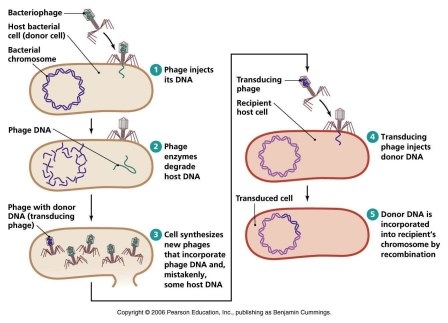Introduction
Transduction is a mode of genetic transfer from one bacteria to another through a virus. There is no direct contact between the bacterial cells. The other ways of genetic recombination in bacteria include transformation and conjugation.
In this process, bacteriophages, which infect bacteria, use host cells to multiplicate and while assembling they sometimes pack the bacterial DNA with them. Later, when these viruses infect new bacterial cells, the bacterial genome that they carry may get inserted into the host genome.
Transduction is commonly used in genetic engineering for inserting foreign DNA into the host cell.
Transduction was discovered by Zinder and Lederberg in Salmonella. Hershey and Chase used transduction as a tool to confirm that DNA is the genetic material.
Bacterial Transduction Steps
In transduction, the transfer of bacterial DNA depends on viral infection. The steps involve:
1.Infection of the bacterial cell by bacteriophage.
2.The virus uses the host machinery to make multiple copies either directly by the lytic cycle or first gets incorporated into the bacterial genome by the lysogenic cycle and followed by the lytic stage.
3.During the assembly of bacteriophages, the bacterial genome also gets packed by mistake in the viral head alongside the viral genome. In the lysogenic cycle, during excision of prophage, some parts of the bacterial genome that flank the prophage are also excised and go inside the assembled viral head together with the viral genome.
4.When these viruses infect another bacterial cell, they inject the viral DNA as well as donor DNA into the host cell.
5.The bacterial DNA either forms plasmids or gets inserted into the recipient DNA if it is homologous to the recipient genome. Most of the time it remains as an extrachromosomal DNA. It can also get inserted with the prophage if it is a temperate phage. So the fate depends on the portion of bacterial DNA and also on the nature of bacteriophages.
Types of Transduction
Transduction is common in both virulent and temperate phages, i.e. by lytic or lysogenic cycle. Transduction is of two types:
a.Generalized Transduction – In this, the phage can carry any part of DNA.
b.Specialized Transduction – In this, the phage carries only the specific part of DNA.
Generalized Transduction
Generalized transduction can occur by both lytic or lysogenic cycle. Here, any random part of DNA gets packed in bacteriophages by mistake along with the viral genome. It occurs at the lytic stage of the phage life cycle.
When the virus-containing bacterial DNA infects another cell, it can get inserted into the host genome or if it was a plasmid, then it can reform the plasmid.
Generalized transduction is used to study linkage information, gene mapping, comparing genomes of two different bacteria, mutagenesis, etc.
Example of generalized transduction includes E.coli transduction by P1 phage.
Specialized Transduction
Specialized transduction can occur only through the lysogenic cycle, i.e. by temperate phage. Here, only the specific part of the bacterial DNA is packed into the virus. It occurs when the prophage, i.e. viral DNA, which gets inserted into the bacterial genome in the lysogenic cycle excises.
When prophage excises from bacterial DNA, some parts of bacterial DNA, which are flanked on both sides of the prophage are also excised. Here, the newly packed phage genome consists of both bacterial and viral genome.
Later, when the virus with the recombinant genome infects a new bacterial cell, the bacterial gene also gets inserted into the host genome with the viral genome through lysogeny. The recipient cell now shows the newly acquired characteristics.
Specialized transduction is commonly used for isolation and insertion of genes of choice.
Example of specialized transduction includes E.coli transduction by 𝝀 phage.
Application of Transduction
Transduction is one of the most important tools for genetic engineering.
Transduction is used to insert the genes of choices in animals and plant cells to modify the genetic constituents and get the desired characteristics.
It can be used for gene therapy. It has huge potential to cure genetic diseases.
It is an important tool in genetics and molecular biology research.





